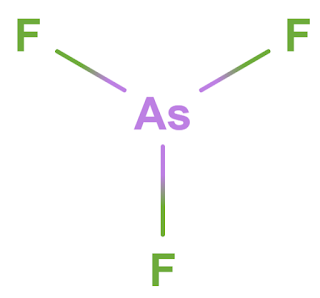Arsenic trifluoride is the chemical name of AsF3 which is a colorless liquid and comfortably reacts with water and decomposes. It is a toxic and corrosive gas. Its molar mass is 131.9168 g/mol, density is 2.666 g/cm3, melting point is -8.5 °C, and the boiling point is 60.4 °C.
It is
prepared by reacting hydrogen fluoride (HF) with arsenic trioxide (As2O3).
6 HF + As2O3 → 2 AsF3 + 3 H2O
Here in
this article, we are going to learn whether AsF3 is a polar molecule or a nonpolar
molecule in detail. But before that first have some ideas about what polar and
nonpolar molecules are:
Polar Molecule
Those molecules
that have a net dipole charge are called polar molecules. In simple terms, if
there is an electronegativity difference between two atoms within the molecule,
induced partial positive and negative charges on either end of the bond. These
types of bonds are called polar bonds.
But being a polar bond is only not enough to make a molecule polar for that molecule must have
an asymmetrical structure so that the induced charges do not cancel.
Xenon difluoride (XeF2), Water (H2O), etc. are some of the examples of polar
molecules.
Nonpolar Molecule
Those
molecules that have zero dipole moment/charge are called nonpolar molecules. It means
if the molecules contain two atoms with two different electronegativity values,
they are referred to as polar molecules. However, a molecule can be nonpolar despite having multiple polar bonds only if the molecule is symmetrical.
Xenon tetrafluoride (XeF4), ethane (C2H6), benzene (C6H6), etc. are some of the examples
of polar molecules.
Checkout:
Difference Between Polar & Nonpolar Molecules With Examples [In Detailed].
So, Is AsF3
polar or nonpolar? Yes, AsF3 is a polar molecule due to the high
electronegativity difference between arsenic (2.16) and fluorine (3.98) which
makes the As-F bond polar. Also, there is one lone pair of electrons present
on the central atom which makes the AsF3 molecule asymmetrical.
AsF3 Polar or Nonpolar (Detailed Explanation)
These are
some of the major aspects on which polarity of the molecules are used to
determine:
Electronegativity difference
Electronegativity
is the tendency of an atom to attract bond pairs of electrons. Different atoms
have different electronegativity values. Higher the electronegativity value, more
closer the atom can pull the bond pairs of electrons.
If there is an electronegativity difference between two atoms, partial positive and negative
charges induced on both ends means atom that has a lower EN value has positive
charge and higher EN value have negative charge induced.
In the case
of AsF3, there are a total of five bond pairs in the form of As-F. Now,
Electronegativity
value of As = 2.16
Electronegativity
value of F = 3.98
Electronegativity
difference = 3.98 – 2.16 = 1.82
1.82 the electronegativity difference between As and F bonds which means all three As-F
bonds are polar in nature according to the Pauli scale.
Lewis Structure of AsF3
Lewis structure
is a pictorial representation of a molecule where each atom’s valence electrons
are placed according to the octet rule. Lewis structure of a molecule helps in
the figure out the molecular geometry, bond structure, hybridization, boiling
point & melting point, etc.
In AsF3,
there are a total of 26 valence electrons present (21 from five fluorine atoms
and 5 from the arsenic atoms). The complete Lewis dot structure is shown in the above
figure.
Molecular Geometry of AsF3
AsF3 (Arsenic trifluoride) has a trigonal pyramidal molecular geometry and also there is one lone pair of electrons present on the central As atom which does not allow canceling dipole charges induced on As-F bonds. The bond angle between F-As-F is 96.2°.
Unlike AsF5
which does not have any lone pair of electrons present on the central atom so that
all the induced As-F dipole charges cancel because it behaves like symmetrical
molecule. That’s why AsF5 is a nonpolar molecule while AsF3 is a polar molecule.
Dipole Moment of AsF3
Dipole moment
is defined as the product between induced charge (Q) and the distance between the
atoms (d).
Dipole
moment = Charge (Q) * distance between the atoms (d)
As the molecule is not symmetrical and there is an electronegativity difference between
the atoms, AsF3 has a net dipole charge which means the molecule is polar.
AsF3 has a net dipole moment of 2.59 D.
Conclusion
In AsF3
(Arsenic trifluoride), there is a large electronegativity difference between
fluorine and arsenic which makes the As-F bond polar. The molecular geometry of the
molecule is pyramidal with one pair of electrons present on the central atom which
does not allow to cancel induced dipole charges, as a result, the molecule has a
net dipole moment means XeF3 is a polar molecule.
This is all
about the article “Is AsF3 Polar or Nonpolar?”. If you have any doubts, connect
with us (by subscribing through the above SUBSCRIBE bottom), you will get an instant response
on your email.



Post a Comment